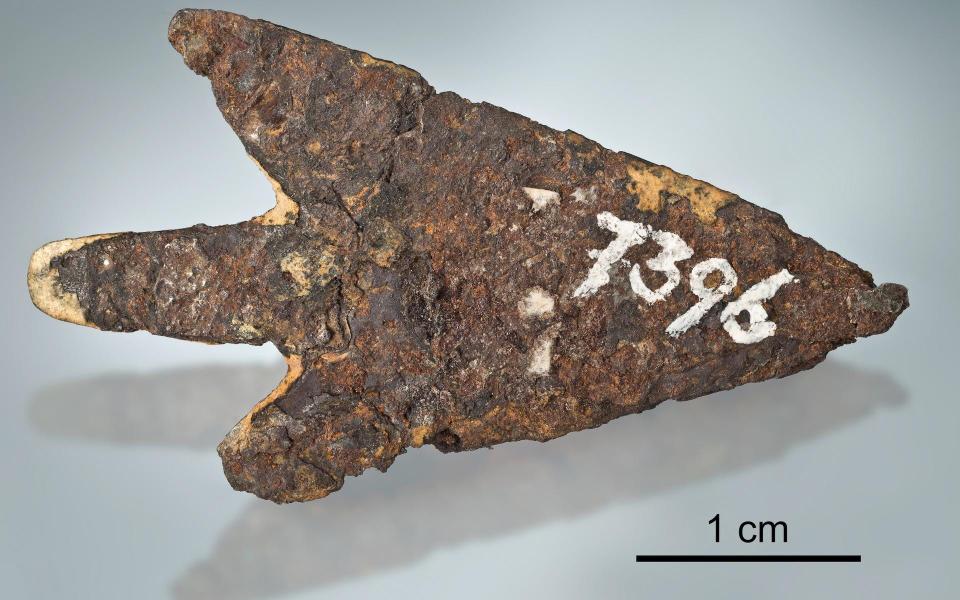3,000-year-old arrowhead found in Switzerland was made with iron from meteorite, researchers say
An ancient iron arrowhead found near Lake Biel in Switzerland, dating back to the Bronze Ages, was likely made of iron that originated from a meteorite, researchers participating in a study by the Natural History Museum Bern have determined.
Researchers, in a study published in the Journal of Archaeological Science, said the arrowhead is 39 millimeters long and weighs 2.9 grams.
"A detailed interdisciplinary study of the arrowhead could confirm beyond doubt that it was made of meteoritic iron," said the researchers in a press release.
Meteorites are "space rocks" that survived their journey through the Earth's atmosphere and hit the ground, according to NASA. The "space rocks," known as meteoroids are objects in space that range in size from dust grains to small asteroids.

The iron arrowhead was originally found during excavations in the 19th century, most likely in the winter of 1873 or 1874, and then acquired by the Bern Historical Museum in Switzerland where it is still in the collections, Professor Beda Hofmann, Director and Curator Mineralogy and Meteorites at the Natural History Museum of Bern, told USA TODAY.
The iron arrowhead comes from a Bronze Age pile-dwelling station near a lake settlement on the outskirts of Bern and dates back to 900-800 BC, stated the press release, adding that the site of the discovery was only a few kilometers away from the scattering field of the Twannberg meteorite, the largest one found known to have reached Switzerland. Over 2,000 fragments of an iron meteorite that fell to Earth about 170,000 years ago have been found there.
What to know about beech leaf disease: The 'heartbreaking' threat to forests along the East Coast
'Extremely rare'
While iron is a widely used metal today, it was considered to be extremely rare and precious and was only known from meteorites, prior to the Iron Age (800 BC). In fact, only 55 such objects, discovered from 22 different sites, are known in the whole of Eurasia and Africa; 19 objects alone come from the tomb of Pharaoh Tutankhamun in Egypt.
"We do not have any information about the use of the arrowhead," explained Professor Beda. "But, because the material must have been very rare and special, it is unlikely that it had been used for everyday hunting."
"I suspect it was some prestige object or it may have had some spiritual meaning, but, this is pure guesswork. At least in other cases where meteoritic iron was used, it was typically in a situation where a high value of the material is evident (e.g. in the tomb of Tutankhamun)," he added.
Traces of grinding and remnants of tar were also seen on the surface of the arrowhead, indicating that the object was probably used to attach to an arrow, said researchers.
Compostable plastic: Researchers create plastic alternative that's compostable in home and industrial settings
Origins
Methods used for the analysis of the arrowhead include electron-microscope images, X-rays and high-energy radiation analysis.
Researchers during their investigation were also surprised to discover chemical evidence that pointed out that the arrowhead was not from the nearby Twannberg field because it contained around 8.3% nickel, which is almost twice as high as in the Twannberg meteorite.
The arrowhead also had a low concentration of aluminum-26 indicating that the sample comes from the interior of a meteorite, which originally had a mass of at least two tons.
"The most likely origin is assumed to be the meteorite 'Kaalijarv', which fell in Estonia during the Bronze Age [roughly 3,500 years ago]," said researchers. "The fall of this meteorite produced several craters. Since the largest meteorite fragments exploded on the ground, many small splinters must have formed."
The team is conducting further research to trace the arrowhead's journey from Estonia to Switzerland.
The arrowhead will be on display for the public from February 2024 to April 2025 at the Bern Historical Museum.
This article originally appeared on USA TODAY: Arrowhead found near Lake Biel, Switzerland, had iron from meteorite

